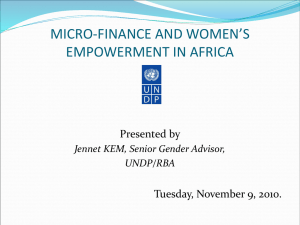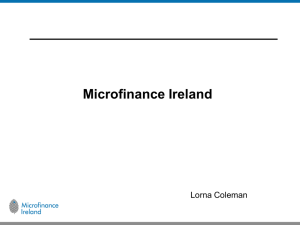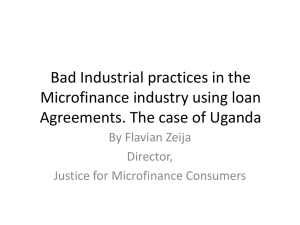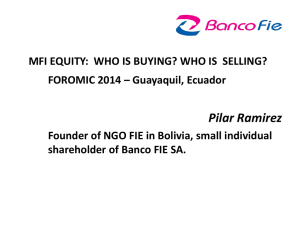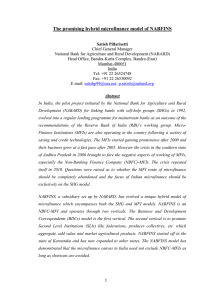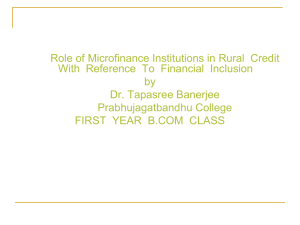Projection meeting
advertisement
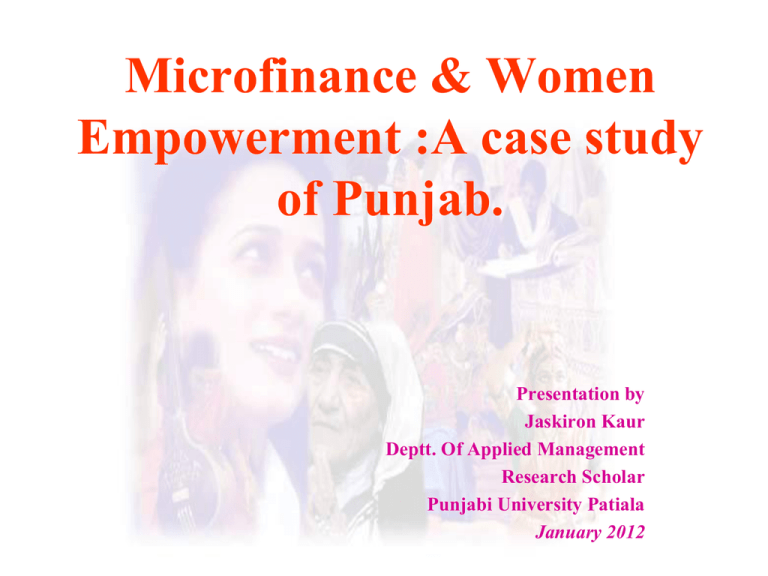
Microfinance & Women Empowerment :A case study of Punjab. Presentation by Jaskiron Kaur Deptt. Of Applied Management Research Scholar Punjabi University Patiala January 2012 Across Centuries, the role of women remains rooted into eternity .Time has gone through many transitions but the status of women remains same .The word empowerment refers to increase in the spiritual,political,social racial, educational ,gender or economic strength of individuals and communities. Empowerment is having / developing confidence in their own capabilities. Most of the women rely on the informal work sector for income. The strategy to empower women to motivate them to create or have their own non-profit organization using the rationale that only marginalize women so that they themselves can know their own people need most and that control of the organization by outsiders can actually help to further entrench marginalization. Micro finance through the network of commercial banks, Cooperative, RRB’s, NGO’s and NABARD has played a major role .MFIs are working for creating a financial provision for the poor. The study is aimed at analyzing the impact of microfinance on socio economic, familial, interpersonal, Legal, Political and psychological empowerment. The study is empirical in nature and based on mainly primary data collected from the field survey .The empirical finding shows that the empowerment of women is established in weak form. The paper has important policy implications. It is appropriate to emphasize the strategy of financial inclusion in the wider sense of economic growth and financial deepening. Robert (2008) in his study titled, “Microfinance Meets the Market” aims to provide reliable banking services to poor customers in a commercially-viable way and analyzes the tensions and opportunities of microfinance as it embraces the market by drawing on a data set that includes 346 of the world’s leading microfinance institutions and covers nearly 18 million active borrowers. The study shows that there is a remarkable success in maintaining high rates of loan repayment, but the study also suggests that profitmaximizing investors would have limited interest in most of the institutions that are focusing on the poorest customers and women. He concluded that those institutions, as a group, charge their customers the highest fees in the sample but also face particularly high transaction costs, in part due to small transaction sizes and suggest innovations to overcome the well-known problems of asymmetric information in financial markets. Tonya (2009) in his study titled, “Microfinance and the Commercial Banking System” observed microfinance as a core component in the development aid programmes, non-governmental organizations (NGOs) and other development groups with the aim to reduce poverty and also, raise the status of women and disadvantaged communities. The author discovered that central banks and the banking sectors in general can promote good and inclusive financial governance in developing countries by adopting microfinance practice and by integrating pro-poor policies into their banking systems. Focusing on the case of Barbados, the study examined the importance of microfinance for commercial banks. The study concluded that the integration of microcredit into the banking and credit schemes of commercial banks and microfinance institutions is a key to promoting good governance. • • Jerniabi et al. (2009) in his study titled, “Microfinance and Empowerment of Muslim Women : A Case Study of SHGs in Coimbatore City of Tamil Nadu” examined large number of parameters in his study like Mobility, recognition in the family or in the ouservices, credit sources, asset building and involvement at different levels of decision- making .The study has shown changes in the socio-economic status of beneficiary after joining SHG, whether the status has increased or decreased or it is at the same level. The authors recommend that planning for women self-employment needs a multi-pronged strategy, procedures for credit access to women should be more easy and simple and further there is a need to evolve new products by the banks which help in long-term sustainability. The study simply demonstrates that SHGs among Muslim women have created conducive environment for growth and development of micro enterprises meeting out the credit needs of its members in terms of improved socio-economic status, income earnings, mobility and confidence building to sustain and manage business on their own. The above survey indicates that though a large number of studies have been conducted on this subject, but no worthwhile research has been conducted related to the measurement of overall performance of microfinance for the empowerment of women and weaker sections of the society and poverty alleviation in Punjab. Although in the present arena so many reservation quotas are prevailing for the suppressed people and women but still there exists a glass ceiling. The present study titled, “Microfinance and Empowerment of Weaker Sections of Society: A Case Study of Punjab" is an attempt to fill the gap. Objectives of the Study • To assess the activities of Microfinance Institute. – The process – Procedure & Implementation • Impact Study of Microfinance for empowering women. – Socio Cultural, Economic, Interpersonal, Legal, Political and Psychological • Negative Impact on Women & Limitation to Empowerment The core Process of Microfinance Institute • • • • • • • • • Village Survey Projection / Mini projection Meeting Group Formation Compulsory Group Training Group Reorganization Test Center Meeting Proposal Meeting Documentation Loan Utilization Check Village Survey • • • • • • • • • Road Accessibility Village population Minimum 60 house holds Branch to below 25 Km's Political stability & Safety Other MFI repayment Agricultural land ,Daily wages Migration sources Economic Activities STAFF SELECT VILLAGE ON BASIS OF POVERTY, POOR HOUSEHOLDS, ROAD ACCESSIBILITY, POLITICAL STABILITY AND SAFETY Village survey assesses population, economic activities, agricultural land, sources of irrigation, and presence of government development programs Initial Projection meeting and follow-up visit for interested villagers and to directly appeal to those hesitant due to religious, class, caste, or gender barriers Groups are self-formed and undergo 4 days of Compulsory Group Training to learn arithmetic, how to sign their names, the importance of savings, and collective responsibility Loans are distributed to the group members at weekly center meetings. Disbursements are staggered to inculcate credit discipline. Repayments are collected over subsequent weeks Compulsory Group Training 1.Greet members Namaste 2.Introduction – Field assistant 3.Introduce - organization 4.Introduction - members 5.Teach Signatures 6.Distribute pledge papers group members 7.Explain Purpose of 05 member group (seeds as a visual) 8.Explain group characteristics 9.Explain responsibilities group leader 10.Members choose 2 group leaders 11.Explain member ship fee & inform members to pay 12.Close meeting – recite pledge Projection / Mini projection Meeting • • • • • • • • • • • • Pre-projection meeting in branch Projection meeting place public places or Govt. buildings Before 1 hour reach village Senior staff ,ABM,BM CGT lights, mat, visual aids ,chalk powder Staff Introduce Why do we credit ? Why poor ? Why only women center ? products details Interest details Loan repayments Group Reorganization Test 1.Housing survey verification by BM with Staff 2.Open session with pledge 3.Members practice signatures 4.Collect member ship fee 5.Members take Group recognition Test by 3 days CGT process 6.Ensure group under stands rules/ policies 7.Group & Center response for members 8.Members signature on GRT form 9. FA signature on GRT form 10.BM signature on GRT form 11.Close meeting – recite pledge Parliamentary Committee on Empowerment of Women National Commission for Women What, Why ,When, Who ? Policies • Loans issued & Applications taken –group attendance 100% Center attendance 75% • Replacement 1 day CGT ,2nd day GRT • Replacement 1 day before drop out • Replacement member 3rd week application taken ,4th week loan issued • CGT ,GRT conducted only 3 groups • MTL issued 21st –40 th week • Disbursement 02:03 maintain • Member ,FA new padam telling • Center meeting group wise members sitting right side by Staff Objective -2 Impact of Microfinance for empowering women. Impact on Economic decision making Impact on Self Confidence Impact On women‘s Status and Gender Relation in house Impact on Family Relationships and Domestic Violence Impact on Women‘s Involvement and status in the Community Impact on Political Empowerment and Women’s Right Negative Impacts on Women and Limitation to Empowerment Holistic approach to Empowerment Health & Nut. Water & San. Political Participation Education Asset base Skills Marketing Technology Credit The study will answer the following ? Does participation in MFIs increase the woman’s influence over economic resources and participation in economic decision making? Does participation in MFIs influence the individual development and growth of a woman? ls there an increase in a woman’s influence in decision making in the household? Has participation in MFIs increased a woman’s mobility, development of networks and interactions with other members of her group and community? Does participation in MFIs increase a woman’s awareness and knowledge? An empirical study on empowerment of women conducted in Patiala Punjab This study has been conducted by me in Patiala district of Punjab 2011.100 SHGs in Sanour, Sangrur, Ablowal ,bhadson ,Kauli and kakrali are some of the villages of Patiala district in Punjab have been selected purposively. This district was selected on the basis of highest number of SHGs formation. Two members from each group have been selected. These sample members are asked questions on the economic decision making variables, purchase variables, purchase variables, control over loans, and control over income and savings etc. •Basic socio-economic characteristics of the sample SHGs members In the present study, About 88% of the SHG members belonged to the age group 21 to 50 years which is the most productive period. Among the respondents, about 20% were in the age class 36-40 years, 12.73% in 31-35 years, 30.09% in 26-30 years and 9.09% in 41-45 years and 5.46 % in 46-50 years More than 63% of SHG members belong to the SC and ST The education level of SHG members in satisfactory. More than 80% SHG members have got primary and high school level of education The sample SHG members tool loan up to 4 times. The average present loan per SHG member is Rs. 5024/-. The average first, second and third loan per SHG member is Rs. 2273.00, Rs. 3533/and Rs. 4772/- respectively. The average saving per SHG member is Rs. 2055/The SHG members who took loan and most of the loan utilized in consumption purposes except 3rd loan. Consumption consists of medical purposes, education of children, house construction, and repayment of old debts etc Impact on Women Economic Decision Making For each of four economic issues, women were asked how their household arrived at decisions and whether they themselves spent money on such projects. The issues were (1) house repair and construction, (2) live stock sale and purchase (3) borrowing money (4) transaction involving household equipment. For the last three issues, roughly half of respondents answered that they and their husbands jointly decided on the issue and implemented the action together (53,54 and 47% respectively). For the issue of housing repair/construction the figure was about two theirs. For each issue less that 3% of respondents answered that they themselves decided on these issues along. Similarly, for all four issues almost all the respondents (98,98,97 & 98.5% respectively) said that they themselves do not spend money in such matters rather it is the husband that actually handled the money in the transaction. Purchasing capacity For sever categories of common household purchases (food, toiletries, candies for the children, cooking, children’s clothing, and own clothing) women were asked whether or not they make the purchase without their husbands permission. The percentage of women who answered that they make purchases themselves varies widely by category, from less than five percent (for furniture) to more than 60% (for candies and house hold utensils) Impact On women‘s Status and Gender Relation in house Even if they are poor or powerless or as power less as a poor woman but because of the social norms or can say patriarchal structure male remains privileged in the family. In some cases the gender relation in the house hold has become better when the house become a comfortable place to work. Status within the community is also enhanced during the scheduled interview one husband commentated that it is good that she is earning as she is not asking for money for her personal requirement. Impact on Family Relationships and Domestic Violence The number of incidence can be quoted where they has a tarnish relation. Three different observations were seen Increased violence. Both started working (as husband) Evidence suggested micro finance have given them a mean to escape from abusive relation Impact on Women‘s Involvement and status in the Community The study shows that women themselves relies/perceive that they received more respect from family and community and their success in business is highly visible Observations Increased in knowledge Increased in self confidence Increase in self esteem Negative Impacts on Women and Limitation to Empowerment Negative impacts Limitation to empowerment Both man and woman assume stress and dependency Additional risk and responsibility Husband takes all the controls over loan amount Knowledge & Awareness Completely Sometimes rarely never 2 To large extent 3 Group Activities 1 4 5 Meeting calendar of the group 1 2 3 4 5 Rules and regulations of the group 1 2 3 4 5 The group record 1 2 3 4 5 Cash in hand of the group 1 2 3 4 5 Balance in bank account of the group 1 2 3 4 5 Total Loaning of the group 1 2 3 4 5 How many group member have taken loan 1 2 3 4 5 Members repaying loan regularly 1 2 3 4 5 The dealing bank 1 2 3 4 5 Income of the group through interest/fine 1 2 3 4 5 The objective of the Group 1 2 3 4 5 Bank transaction 1 2 3 4 5 Constrained of the group 1 2 3 4 5 Achievement of groups 1 2 3 4 5 Training & Orientation Completely Sometimes To large extent rarely never Not at all To a very small extent To small extent To a large extent To a very large extent Training given by MFIs On site (at the place work place) 1 2 3 4 5 Training given by MFIs off site 1 2 3 4 5 Industrial visits conducted by MFIs 1 2 3 4 5 Do you think training has covered all the technical aspects required 1 2 3 4 5 Workshops conducted by MFIs were knowledgeable. 1 2 3 4 5 MFI training helped in marketing linkage. 1 2 3 4 5 The programs conducted by MFI have given you skill set to work. 1 2 3 4 5 Impact of training, orientation & exposures Do you think after joining MFI Not at all To a very small extent To small extent 3 To a large extent 4 To a very large extent 5 You have knowledge on your Rights 1 2 You are aware of your entitlement as a member of group. 1 2 3 4 5 Your confidence has increased towards work. 1 2 3 4 5 You have attained the skills to work. 1 2 3 4 5 You have better linkage with banks 1 2 3 4 5 You have knowledge of schemes/ Govt. benefits available 1 2 3 4 5 You have better market linkage 1 2 3 4 5 You have enhanced your income. 1 2 3 4 5 You actively participate in decision making in the family 1 2 3 4 5 Your confidence has increased towards work Economic decision making Yes To a large extent To some extent Rarel y Never Use of loan amount 1 2 3 4 5 Regarding the business/work to be started with the loan amount 1 2 3 4 5 Regarding the use of income generated by the business 1 2 3 4 5 Regarding the spending of your income/earning 1 2 3 4 5 Do you think you can take decision for house hold infrastructure/ smokeless chulla/house hold repair 1 2 3 4 5 Do you think you can take decision for house hold purchases like farm equipment/live stock 1 2 3 4 5 Development & Growth Strongly Agree Agree rarely Disagr ee Strongly disagree Your literacy level has increased 1 2 3 4 5 Your education level has increased 1 2 3 4 5 Your knowledge for the work has increased 1 2 3 4 5 You can manage work independently 1 2 3 4 5 You can arrange meetings independently 1 2 3 4 5 You can express your views independently 1 2 3 4 5 Your family/people respect you and your decisions. 1 2 3 4 5 You have better market linkage 1 2 3 4 5 You have enhanced your income. 1 2 3 4 5 You actively participate in decision making in the family 1 2 3 4 5 Voicing Concern After joining MFI ,do you think you Not at all To a very small extent To small extent To a large extent To a very large extent Can take decision for education of your children 1 2 3 4 5 Can take decision for the education of girl child 1 2 3 4 5 Can take decision for carrier of your children 1 2 3 4 5 Have freedom for willful dresses 1 2 3 4 5 Have freedom to choose life partner 1 2 3 4 5 Have freedom to use family planning methods 1 2 3 4 5 Have better check on domestic violence/alcoholism 1 2 3 4 5 Can take an action against dowry system/ pardah system 1 2 3 4 5 Political empowerment Since you have joined an MFI you Very often occasionally often Rarely never Participate in the meetings of village panchayat 1 2 3 4 5 Participate in the meeting of village gram sabha 1 2 3 4 5 Participate in the elections as a voter 1 2 3 4 5 Participate as a candidate in the local body candidates 1 2 3 4 5 Have ever been selected as a member 1 2 3 4 5 People perception towards woman working in MFI Since you have joined MFI People consider you as Strongly Agree Agree rarely Disagre Strongly e disagree A part of well organized family 1 2 3 4 5 Heaving Good relationship with husband 1 2 3 4 5 You have control our savings and Expenditure 1 2 3 4 5 You are considered as more aware and respected woman 1 2 3 4 5




